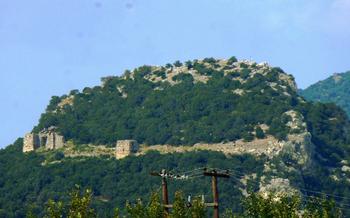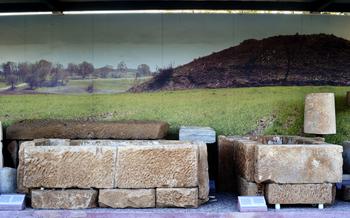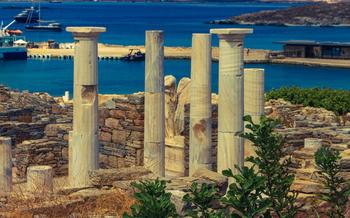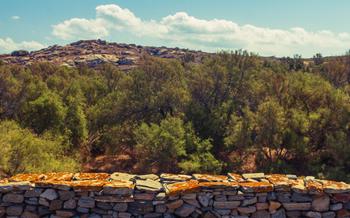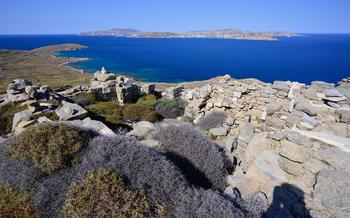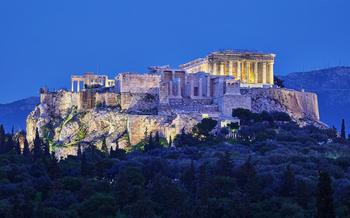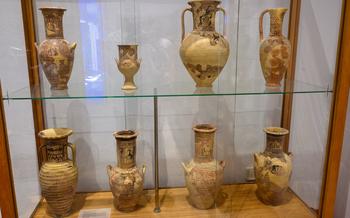
Abdera Archaeological Site
- Abdera Archaeological Site: A Journey Through Time
- Unearthing the Past: Archaeological Excavations
- A Stroll Through Ancient Abdera
- The Agora: Center of Public Life
- The Theater: A Stage for Ancient Drama
- The Temple of Apollo: A Sacred Sanctuary
- The Necropolis: A City of the Dead
- The Museum of Abdera: A Treasure Trove of Antiquities
- Mosaics and Frescoes: Vibrant Artworks
- The Sanctuary of Artemis: A Sacred Grove
- Festivals and Events: Reviving the Past
- Local Cuisine: A Taste of Tradition
- Accommodations and Amenities
- Insider Tip: Explore the Surrounding Area
Abdera Archaeological Site: A Journey Through Time
The ancient city of Abdera, a prominent cultural and economic center in northeastern Greece, boasts a rich history dating back to the 7th century BC. Situated on a fertile plain near the Nestos River, Abdera's strategic location contributed to its prosperity and prominence throughout antiquity. Today, the Abdera Archaeological Site stands as a testament to the city's glorious past, offering visitors a glimpse into the architectural marvels, cultural traditions, and daily life of an ancient Greek city-state.
Historical significance: Abdera played a pivotal role in the political and cultural landscape of ancient Greece. Founded by colonists from Clazomenae in Ionia, Abdera quickly rose to prominence as a center of commerce and maritime trade. The city's strategic location at the intersection of major trade routes made it a hub for goods and ideas from across the Mediterranean. Abdera's flourishing economy attracted renowned philosophers, poets, and artists, contributing to its reputation as a vibrant intellectual and cultural center.
Location: The Abdera Archaeological Site is situated just 17 kilometers east of the modern city of Komotini, in the region of Eastern Macedonia and Thrace. Nestled amidst lush greenery and rolling hills, the site offers a serene and picturesque setting for exploring the remnants of this ancient metropolis.
Highlights of the site: The Abdera Archaeological Site encompasses a vast expanse of ruins, providing a glimpse into the city's urban layout and impressive architectural achievements. Among the highlights of the site are the monumental Agora, the well-preserved Theater, the sacred Temple of Apollo, and the expansive Necropolis. Visitors can wander through the ancient streets, admire the intricate mosaics and frescoes adorning the buildings, and immerse themselves in the rich history of this remarkable city.
Unearthing the Past: Archaeological Excavations
The Abdera Archaeological Site, as a treasure trove of ancient artifacts and historical insights, owes its present-day state of preservation and understanding to the meticulous work of archaeologists and researchers. The history of excavations at Abdera dates back to the late 19th century, with sporadic digs conducted by foreign expeditions. However, it was in the 1950s that systematic and large-scale excavations began under the direction of the Greek Archaeological Service.
These excavations, spanning several decades, have uncovered a wealth of significant discoveries that shed light on Abdera's rich past. Among the most notable finds are the remains of the city's fortifications, public buildings, temples, theater, and agora. These structures reveal the urban layout, architectural styles, and civic life of ancient Abdera.
Furthermore, the excavations have yielded an abundance of artifacts, including pottery, coins, jewelry, tools, and sculptures. These objects provide valuable insights into the daily lives, economic activities, and cultural practices of the Abderites. Ongoing research at the site continues to uncover new information and artifacts, contributing to our understanding of this ancient city's history and significance.
A Stroll Through Ancient Abdera
The ancient city of Abdera was laid out on a grid plan, with wide streets and public spaces. The city walls, which were constructed in the 5th century BC, were over 5 kilometers long and 10 meters high. They were built with large blocks of stone and had several towers and gates.
Within the city walls, there were a number of public buildings, including the agora, the theater, the temple of Apollo, the gymnasium, and the necropolis. The agora, or marketplace, was the center of public life in ancient Abdera. It was a large, open space surrounded by shops, offices, and temples. The theater was built in the 4th century BC and could seat up to 5,000 people. It was used for performances of plays, concerts, and other events.
The temple of Apollo was one of the most important religious buildings in ancient Abdera. It was built in the 6th century BC and was dedicated to the god Apollo. The temple was a large, rectangular building with a portico of columns on the front. The gymnasium was a public building where young men could train for athletic competitions. It was a large, open space with a running track, a wrestling area, and a swimming pool.
The Agora: Center of Public Life
The agora, or marketplace, was the bustling heart of ancient Abdera. Located near the center of the city, it served as a vibrant hub for trade, social gatherings, and political discussions. Rectangular in shape, the agora was surrounded by stoas, or covered walkways, which provided shelter from the sun and rain. These stoas were lined with shops, stalls, and workshops, where merchants sold a variety of goods, from pottery and textiles to jewelry and spices.
The agora was not only a place of commerce but also a center of civic life. Here, citizens would gather to discuss important issues, make decisions, and conduct official business. Public buildings, such as the bouleuterion (council chamber) and the prytaneion (government building), were located nearby, further emphasizing the agora's significance as the political center of the city.
During excavations, archaeologists uncovered a wealth of artifacts in the agora, including coins, pottery fragments, and inscriptions. These findings shed light on the economic and social activities that took place in this bustling marketplace, providing valuable insights into the daily lives of ancient Abderans.
The Theater: A Stage for Ancient Drama
The theater of Abdera, built in the 4th century BC, is a testament to the city's cultural and artistic achievements. Carved into a hillside, the theater offers a breathtaking view of the surrounding landscape. Its well-preserved structure includes a circular orchestra, a tiered seating area, and a stage adorned with intricate reliefs.
The theater hosted a variety of performances, including plays, musical concerts, and religious ceremonies. The acoustics of the theater are remarkable, ensuring that even the faintest whisper could be heard by the audience. The stage, with its elaborate backdrop, provided a dynamic setting for the actors to showcase their talents.
The theater also served as a venue for civic gatherings and public assemblies. Here, the citizens of Abdera discussed important issues, made decisions, and celebrated their achievements. The theater was an integral part of the city's social and political life, reflecting the vibrant and sophisticated culture of ancient Abdera.
The Temple of Apollo: A Sacred Sanctuary
Architectural Features: The Temple of Apollo, a marvel of ancient architecture, captivates visitors with its grandiose design. Constructed in the 5th century BC, the temple features a rectangular plan with a colonnade surrounding the cella, the innermost chamber. The imposing Doric columns, adorned with intricate capitals, support the entablature, creating a sense of strength and balance. The frieze, once adorned with sculptures depicting mythical scenes, offers a glimpse into the religious beliefs and artistic prowess of the ancient Greeks.
Religious Significance: Dedicated to Apollo, the god of light, music, and prophecy, the temple held a profound religious significance for the people of Abdera. Apollo was revered as a divine protector and guide, and the temple served as a sacred space for worship and offerings. Devotees would flock to the temple to seek divine guidance, offer prayers, and participate in religious rituals, believing that their petitions would be heard and answered by the benevolent deity.
Rituals and Ceremonies: Within the temple's sacred precincts, a variety of rituals and ceremonies took place, each infused with deep spiritual meaning. Priests performed sacrifices and libations to honor Apollo and seek his favor. Worshippers would bring offerings of food, flowers, and precious objects to express their gratitude and devotion. The temple also hosted religious festivals and celebrations, where the community would gather to honor Apollo and reinforce their spiritual bonds.
The Necropolis: A City of the Dead
The ancient city of Abdera was not just a place for the living; it also had a dedicated area for the dead. The necropolis, or cemetery, was located outside the city walls, along the main road leading to the nearby city of Maroneia. It was a vast complex, covering an area of several hectares, and it contained a variety of burial structures.
The most common type of burial in Abdera was the inhumation, in which the body was buried in a grave dug in the earth. Graves were often lined with stones or tiles, and they were sometimes covered with a mound of earth. Some graves were also marked with headstones or other grave markers.
Cremation was another common burial practice in Abdera. In this case, the body was burned on a pyre, and the ashes were collected and buried in an urn. Urns were often made of ceramic or metal, and they were sometimes decorated with inscriptions or other designs.
The necropolis of Abdera also contained a number of mausoleums, which were large, elaborate tombs built for wealthy or important individuals. Mausoleums were typically made of stone or marble, and they were often decorated with sculptures, reliefs, and other works of art.
The grave goods found in the necropolis of Abdera provide valuable insights into the funerary practices and beliefs of the ancient Abderans. Grave goods typically included personal items such as jewelry, clothing, and tools, as well as food and drink offerings. These offerings were intended to provide the deceased with everything they would need in the afterlife.
The necropolis of Abdera is an important archaeological site that provides valuable insights into the lives and deaths of the ancient Abderans. It is a place where the past and the present come together, and where visitors can learn about the rich history and culture of this ancient Greek city.
The Museum of Abdera: A Treasure Trove of Antiquities
The Museum of Abdera is a treasure trove of artifacts and antiquities that tell the story of this ancient city. Located just outside the archaeological site, the museum houses a vast collection of objects excavated from Abdera and the surrounding region.
Collections and Exhibits: The museum's collection is divided into several sections, each showcasing a different aspect of Abdera's history and culture. Exhibits include pottery, jewelry, tools, weapons, coins, sculptures, and inscriptions. These artifacts offer a glimpse into the daily lives of the ancient Abderites, their artistic achievements, and their religious beliefs.
Highlights of the Museum: Among the highlights of the museum's collection are a stunning bronze statue of the goddess Artemis, dating back to the 4th century BC. A well-preserved mosaic floor depicting scenes from Greek mythology, intricate gold jewelry, and a collection of ancient coins from various periods. These artifacts provide valuable insights into the artistry, craftsmanship, and economic activities of ancient Abdera.
Educational Programs: The Museum of Abdera is not just a repository of artifacts but also an active center for education and research. The museum offers guided tours, educational programs, and workshops for students, researchers, and the general public. These programs aim to promote the understanding and appreciation of Abdera's rich cultural heritage.
Mosaics and Frescoes: Vibrant Artworks
The ancient city of Abdera was not only known for its impressive architecture but also for its vibrant artistic traditions. Mosaics and frescoes adorned the floors and walls of many buildings, adding color and beauty to the urban landscape.
The mosaics, meticulously crafted from small pieces of colored stone or glass, depicted intricate patterns, geometric designs, and scenes from mythology. These stunning artworks showcased the skill and creativity of the ancient artisans and served as a testament to the flourishing artistic culture of Abdera.
The frescoes, on the other hand, were painted directly onto the walls of buildings using pigments derived from natural minerals and plants. These colorful murals often depicted mythological figures, historical events, or everyday scenes, offering a glimpse into the lives and beliefs of the ancient Abderans.
The mosaics and frescoes that have survived the passage of time provide valuable insights into the artistic sensibilities and cultural heritage of ancient Abdera. Visitors to the site can admire these beautifully preserved artworks and marvel at the skill and artistry of the ancient craftsmen who created them.
The Sanctuary of Artemis: A Sacred Grove
Located just outside the ancient city walls, the Sanctuary of Artemis was a sacred grove dedicated to the goddess Artemis, the protector of nature and the hunt. This serene and tranquil spot was a place of worship and pilgrimage for the people of Abdera and the surrounding region.
The sanctuary consisted of a series of altars, temples, and other structures arranged around a central courtyard. The main temple was adorned with intricate carvings and sculptures depicting Artemis and her sacred animals, such as the deer and the bear. Within the sanctuary, worshippers would make offerings to the goddess, pray for her protection, and participate in religious rituals and festivals.
One of the most important festivals held at the Sanctuary of Artemis was the Artemisia, which took place annually in the spring. During this festival, people from all over the region would gather to honor the goddess with processions, sacrifices, and other rituals. The sanctuary was also a popular destination for pilgrims who sought healing and guidance from Artemis.
Today, the Sanctuary of Artemis lies in ruins, but its atmosphere of peace and spirituality still lingers. Visitors can explore the site and imagine the vibrant religious life that once took place here.
Festivals and Events: Reviving the Past
The ancient city of Abdera comes alive each summer during the annual Abdera Festival, a vibrant celebration of the city's rich history and cultural heritage. This immersive festival transports visitors back in time, recreating the sights, sounds, and atmosphere of ancient Abdera.
During the festival, the streets of Komotini are transformed into a bustling marketplace, filled with vendors selling traditional crafts, local delicacies, and souvenirs. The air is filled with the sounds of music, laughter, and the chatter of people in period costumes.
Visitors can immerse themselves in the ancient world by attending theatrical performances, participating in workshops on ancient crafts and customs, and sampling traditional Greek food. The festival also features exhibitions of ancient artifacts and historical reenactments, bringing the past to life in a tangible and engaging way.
One of the highlights of the festival is the recreation of ancient rituals and ceremonies, allowing visitors to witness firsthand the religious practices of the ancient Greeks. These rituals, often accompanied by music, dance, and offerings, provide a glimpse into the spiritual beliefs and traditions of the Abderans.
The Abdera Festival is a unique opportunity to experience the rich cultural heritage of Greece and to connect with the spirit of ancient Abdera. It is a celebration of the city's glorious past and a testament to the enduring power of its legacy.
Local Cuisine: A Taste of Tradition
Immerse yourself in the culinary delights of Komotini, where traditional Greek flavors dance on your palate. Begin your gastronomic journey with "Giouvarlakia", a comforting soup featuring tender meatballs simmering in a savory tomato broth. Savor the "Pastitsio", a baked pasta dish adorned with a creamy béchamel sauce and layers of minced meat. For a taste of the sea, indulge in "Grilled Octopus", expertly charred and drizzled with olive oil and lemon juice.
Don't miss "Saganaki", a sizzling pan-fried cheese that will tantalize your taste buds. Vegetarian enthusiasts will delight in "Gemista", a medley of stuffed vegetables brimming with aromatic rice, herbs, and spices. Accompany your meal with "Tzatziki", a refreshing cucumber-yogurt dip, and "Horta", a flavorful dish of wild greens.
Quench your thirst with "Ouzo", a traditional anise-flavored liqueur, or "Tsipouro", a grape-based spirit. For a sweet ending, indulge in "Loukoumades", golden-brown doughnuts drenched in honey syrup and sprinkled with cinnamon. Embark on a culinary odyssey in Komotini, where every bite tells a story of Greek heritage and tradition.
Accommodations and Amenities
When planning a trip to Komotini, you'll find a range of accommodation options to suit different budgets and preferences. From comfortable hotels to charming guesthouses, there are plenty of places to rest and recharge after a day of exploring Abdera and the surrounding area.
For a luxurious stay, consider the 5-star Komotini Palace Hotel, which offers elegant rooms, a spa, and a rooftop restaurant with panoramic city views. For a more budget-friendly option, the Hotel Elisso offers clean and comfortable rooms just a short walk from the city center.
To fully immerse yourself in the local culture, consider staying at a traditional Greek guesthouse. The Filoxenia Guesthouse is a popular choice, offering cozy rooms and a warm hospitality that will make you feel right at home.
Once you've settled in, you'll find plenty of restaurants and cafes near the archaeological site to satisfy your hunger. From traditional Greek tavernas serving mouthwatering souvlaki and moussaka to modern cafes with international cuisine, there's something to suit every taste.
Transportation in Komotini is convenient and affordable. The city has a well-connected public bus system that can take you to the archaeological site and other attractions. If you prefer to explore at your own pace, you can rent a car or hire a taxi.
To make the most of your visit, plan your trip during the annual Abdera Festival, held in August. This vibrant festival brings the ancient city to life with performances, exhibitions, and workshops that showcase the rich history and culture of Abdera.
Insider Tip: Explore the Surrounding Area
Abdera may be the star attraction of Komotini, but the surrounding region offers a wealth of hidden gems waiting to be discovered. History buffs can delve into the past at the nearby archaeological sites of Maroneia and Mesimvria, while nature enthusiasts can immerse themselves in the breathtaking beauty of the Nestos Delta National Park. For a taste of local culture, visit the traditional villages of the Rhodope Mountains, where you can sample regional delicacies, learn about traditional crafts, and experience the warm hospitality of the locals. Whether you're seeking adventure, relaxation, or a deeper connection with Greek history and culture, the area surrounding Abdera promises an unforgettable journey.
